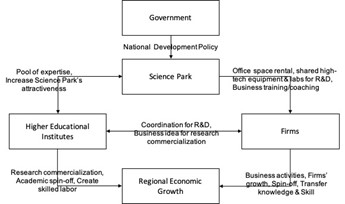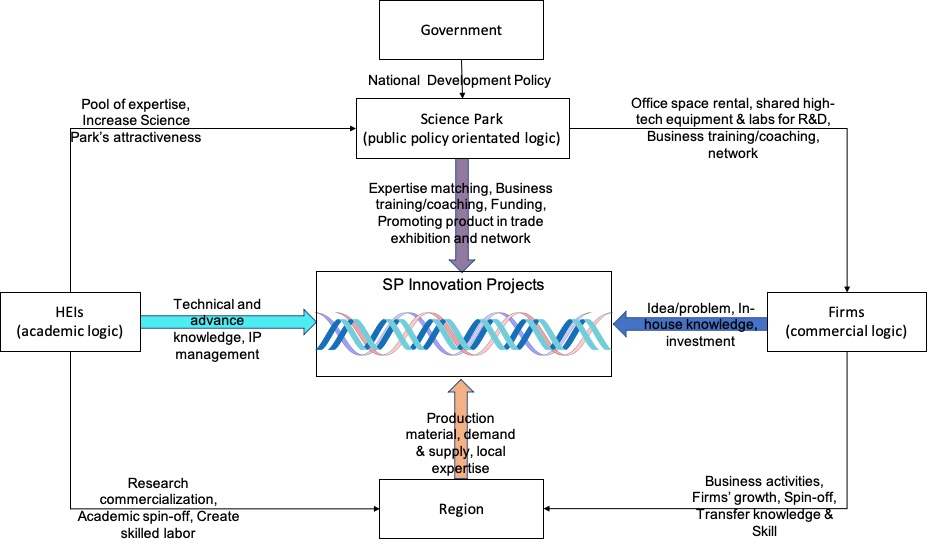Knowledge Sharing ชุมชนแห่งการเรียนรู้...
 Science Park development and policy interventions in emerging economies 844
Science Park development and policy interventions in emerging economies 844
 Science Park development and policy interventions in emerging economies 844
Science Park development and policy interventions in emerging economies 844
The evolution of regional development policy has been based on policy attempt to understand each area's economic geography, but the danger is that Science Park (SP) policy is applied in a new setting based on existing policy (Uyarraet al., 2017). Place-specific policy must be based on an approach that emphasises applying innovation within the context of an entrepreneurial ecosystems with a focus on the development of linkages between firms and sources of knowledge within the context of a specific place (McCann and Ortega-Argilés, 2013; Grillitsch and Asheim, 2018; Bramwell, Hepburn and Wolfe, 2019). One emphasis must be on creating new pathways in local economies based on the development of firm-based innovations that enhance regional competitiveness. In this account, a SP acts as a bridge to connect private businesses with the higher education institutes (HEIs) and the resulting bridging process is intended to create, stimulate, and support knowledge transfer.
Understanding SP development
The SP concept was developed in the 1950s (Guy, 1996) as a tool for the implementation of place-based innovation policy (Lamperti, Mavilia and Castellini, 2017; Albahariet al., 2018). The triple helix model has been applied as a framework of SP policy implementation (Etzkowitz and Zhou, 2018). The level of cooperation from key actors differs based on the local context, and these differences in local context matter as they influence innovation outcomes. To Saxenian (1994); Garnsey and Heffernan (2005), SPs in developed countries were predominantly established by private businesses working collaboratively with HEIs, and the government’s role was as supporter. In contrast, SPs in less developed countries are usually established as a government initiative.
Local SMEs and startup firms were usually the primary target of a SP policy. A SP's support mechanisms include R&D funding support, the use of high-technology tools and equipment available from HEIs, and business incubation programs. Relationship between the HEIs and businesses are encouraged to enhance firm-level innovation. These relationships are primarily based on mutual interest in the technology and the project, rather than the distance between them (Goddardet al., 2014). However, proximity makes it easier to create and maintain a relationship (Andres and Bryson, 2018). Thus, the establishment of a SP involves engagement with local HEIs with related technology to support local businesses and new and emergence firms and industries. Some SPs succeed, and some fail. One issue is that low levels of contribution from government authorities, and HEIs compromise SP operational outcomes (Etzkowitz and Zhou, 2018). Another issue is that poorly matched entrepreneurs with academics discourage cooperation and knowledge transfer. Also, balancing on-site firms within a SP is critical for ensuring financial sustainability of the SP and to release broader regional impacts. Larger firms can attract smaller firms with related products to the SP or the area (Cadorin, Johansson and Klofsten, 2017). In more successful cases, knowledge transfer occurred from larger to smaller firms, and smaller firms also stimulated regional economic activities in the SP’s region.The selection criteria to allocate project funding must be set and carefully followed to ensure that funding was granted to firms with the potential to succeed and not to firms that had relatively low levels of commitment to innovation processes. Furthermore, there is a need to create connections between regions for market expansion and to identify new knowledge to ensure that firms remain innovative.
Previous understandings of SP analysis were highlighted in Figure 1, but this only identified a broad relationship between the government as an actor within a SP, HEIs, and the firms in establishing a SP highlighting the benefits to regional economic growth. Combining the triple helix, Innovation Value Chain (IVC), and string-based approaches to the analysis has enhanced understanding of SP ecosystems by highlighting the importance of placing projects within the context of firms and the IVC, and then placing firms within the context of the triple helix. Moreover, it shows the contributions of each actor in supporting SP innovation projects by linking the project level to the institutional level that is highlighted in the triple helix framework (Figure 2).

Figure 1 Relationship of SP, HEIs, and firms (triple helix)

Figure 2 Relationship of SP, HEIs, firms, and the region supporting SP policy implementation at a project level.
A SP innovation system requires support from the government, HEIs, the private business sector, and the region. At the institutional level, the government implements the SP policy providing SP services to firms. The HEIs contribute to the SP by offering a pool of expertise and the reputation of the HEIs helps increase SP attractiveness. The region benefits from economic activities and knowledge transfer created by a SP. At the project level, an individual from each institution working collaboratively and provides different inputs that may be conceptualised by applying an IVC framework that highlights that an innovation project requires materials, local knowledge, and demand within the region. Individuals, including an entrepreneur, an academic, and a SP officer may act in relation to the institutional logic that reflects their institutional affiliation. Logics from different institutions are blended or braided together and influencing project outcomes.
Points to consider for policymakers
SP policy is a useful tool for implementing place-based innovation policy. However, some weaknesses must be considered.
1. Making sure that a project’s braid contains the right combination of strings.
A project braid contains at least three key strings: the SP coordinator, academic, and entrepreneur. They have different logics and interests in participating in a SP innovation project. The vibration of some strings may create destructive interference and may need to be adjusted or a string removed/replaced to enhance successful outcomes. For example, the researcher who has a strong academic logic and directs the project toward academic achievement should be reminded that the goal of the SP project is product commercialisation. This means there should be more monitoring of projects to identify weaknesses early on and remove or replace partial strings or strings that create un-supportive vibrations within the braid. This could, for example, include the application of a 360-degree appraisal process of project partners involved in a braid to identify problems that result from tensions between different institutional logics that have been combined within a project braid.
2. Managing the critical inputs required to support each project.
In the context of Thailand, this thesis identified that initially the triple helix model was applied as a top-down management approach which treated every project/firm in the same manner. Thus, initially within emerging economy settings a learning process is required to appreciate that SP policy must be contextualized and this includes understanding the ways in which interventions must be customized to meet the needs of individual firms and their projects. This also suggests that there are capability deficiencies that could be partly overcome with training, for example, by training academics to appreciate the different challenges facing innovation processes within the context of a private sector firm. Chapter Six of this full study highlighted that each project requires different inputs at each IVC stage, and the level of inputs was different from project-to-project. SP policy implication at the level of an individual SP needs to be agile to account for the diversity of projects and business needs. It is not a one-size-fits-all policy but requires considerable adjustment to meet each project's needs. The project may require regular intervention during the process or at the end of each IVC stage to identify and to make sure that the critical inputs that are required are in place.
3. The barriers obstructing the firm’s innovativeness need to be identified and removed.
SPs' establishment in advanced and emerging economies was based on the same model, 'the triple helix'. However, the context of these two type of economy is very different (Cuervo-Cazurra and Wang, 2020). The emerging economies tend to be transitioning from agriculturally based economies with low technology levels. There is inconsistency in rules and regulations between different government agencies. The entrepreneurs lack access to funding and other types of business support. The implementation of SP policy in an emerging economy setting occurs at a slow pace as universities and private sectors interests are engaging in a transition process. There are barriers that exists elsewhere within the governance structures that supports, or otherwise, innovation in Thailand. Possible solutions rely mainly upon the ability of national policymakers to amend rules and regulations enhancing consistency of the wider framework conditions that support economic activity, providing clear strategies to practitioners and private businesses, and considering supporting schemes that reflect the needs of firms and by persuading academics to participate in SP projects. For example, the government should offer a fast-track service for issuing FDA certificates for products that emerge as outcomes of a SP innovation projects. Cooperation from related authorities is required to diminish barriers. Moreover, regional innovation policies must be developed and applied over a long time period and this requires cross-party agreement to ensure policy continuity over the electoral cycle (Albahariet al., 2018).
Conclusion
The establishment of SPs has been a feature of place-based innovation policies across developed economies since the 1950s. The application of SP policy in different regional settings has been inspired by the theory of the triple helix. However, this theory presupposes a framework of well-established institutions - universities, venture capitalists, and high-tech businesses - that may still be in a formative stage in an emerging economy setting. Understanding innovation in emerging economies is utterly critical because one of the most important ways of meeting the sustainable development goals (SDGs) is by providing alternative approaches to wealth creation and this requires contextualized innovation to develop appropriate solutions. These alternative approaches must be contextualized within the context of each emerging economy setting. There have been attempts to transfer SP policy formulated in developed countries to emerging economy settings. However, the context of emerging economies has more barriers than developed market economies creating difficulties in encouraging innovation and one consequence may be limited or perverse outcomes. Thus, innovation approaches that have emerged from developed market economies must only be applied to emerging economy settings with considerable care and sensitivity. Context matter and this is especially the case for innovation processes.
This thesis suggests that the application of a triple helix informed SP analysis is relevant to developed economies but has less validity within emerging economy settings where the components of the triple helix are not yet fully established. Only applying a triple helix-based approach highlights limitations and restrictions within the institutional environment existing in emerging countries that obstruct the innovation process. These limitations include access to limited resources for entrepreneur development, the inconsistency of supporting policies, and an underdeveloped or weak HEI structure. These challenges are too complex to overcome without having long-term strategies and implementing the reconstruction at a national level. Alternatively, one can develop and apply a small steps approach to enhance innovation by, perhaps, focusing on what and how innovation projects are being developed within an emerging economy setting focusing on the local context to formulate policies to meet local needs. This means that extremely complex or sophisticated policies that attempt to replicate developed market economies initiatives may be less effective compared to more modest policy interventions based around an appreciation of local conditions and needs.
Regional innovation policy development needs a series of tools that are designed to supplement the triple helix approach, and which are based on understanding the conditions that support successful innovation in specific collaborative projects. The IVC approach provides one way to conceptualise firm-level innovation highlighting the critical inputs required for an innovation project and the relationship created between project team members and the ways in which these influence project the outcomes. The triple helix and IVC approaches, then, supplement one another and then this requires an additional or more granular approach. This additional approach is the string-based approach that has been developed in this thesis from an analysis of innovation projects within an emerging economy setting. The string approach is a project-based approach. This granularity of this approach appreciates differences in the combinations of expertise that are braided together within SP innovation projects. Within this braiding process, there are challenges in balancing institutional logics and releasing tensions between team members. This string-informed approach to exploring firm-level innovation processes highlights the importance of appreciating conflicts between the institutional logics that are combined within a braid. The outcome of this new approach leads to the identification of a new policy pathway that is required in emerging economy settings to overcome some of the barriers to firm-level innovation. Developing local policy solutions to overcome some of the project barriers and difficulties that have been identified in this thesis would go some way towards developing solutions that might contribute to meeting the SDG goals.
พยายามเพิ่ม bibliography แต่ระบบดีดออกตลอดเลยค่ะ ถ้าสนใจอ่านเพิ่มเติม journal ไหนขอเพิ่มได้นะคะ
